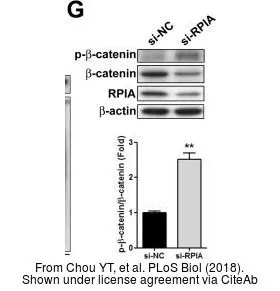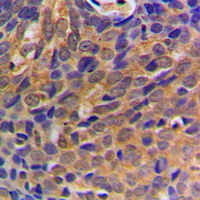beta Catenin antibody
GTX26302
ApplicationsDot Blot, ImmunoFluorescence, ImmunoPrecipitation, Western Blot, ImmunoCytoChemistry, ImmunoHistoChemistry, ImmunoHistoChemistry Frozen, ImmunoHistoChemistry Paraffin
Product group Antibodies
TargetCTNNB1
Overview
- SupplierGeneTex
- Product Namebeta Catenin antibody
- Delivery Days Customer9
- Application Supplier NoteWB: 1:4,000. ICC/IF: 1:2,000. IHC-Fr: 1:2,000. *Optimal dilutions/concentrations should be determined by the researcher.Not tested in other applications.
- ApplicationsDot Blot, ImmunoFluorescence, ImmunoPrecipitation, Western Blot, ImmunoCytoChemistry, ImmunoHistoChemistry, ImmunoHistoChemistry Frozen, ImmunoHistoChemistry Paraffin
- CertificationResearch Use Only
- ClonalityPolyclonal
- ConjugateUnconjugated
- Gene ID1499
- Target nameCTNNB1
- Target descriptioncatenin beta 1
- Target synonymsCTNNB, EVR7, MRD19, NEDSDV, armadillo, catenin beta-1, catenin (cadherin-associated protein), beta 1, 88kDa
- HostRabbit
- IsotypeIgG
- Protein IDP35222
- Protein NameCatenin beta-1
- Scientific DescriptionThe distinct peripheral cytosolic proteins, alpha, beta and gamma-catenin (102, 94 and 86 kD) found in many tissues (1,2,3) bind to the conserved cytoplasmic tail domain of the cell-adhesion cadherins. Catenins link E-cadherin to other integral membrane or cytoplasmic proteins and are modulated by Wnt-1 proto-oncogene. (6,7) They are good candidates for mediating transduction of cell-cell contact positional signals to the cell interior. (4,5) Absence of alpha-catenin is found in certain tumor cell lines (8) and reduced levels in certain human carcinomas (9). Beta-catenin binds directly to the cytoplasmic tail of E-cadherin. It binds to the N-terminus of alpha-catenin and interacts with the protein product of the tumor suppressor gene APC. (10) This interaction involves a 15-aa repeat in the APC. (11) Beta-catenin cell levels seem to be controlled by APC. (12) The central core region of beta-catenin is involved in mediation of cadherin-catenin complex interaction with EGFR. (13)
- Storage Instruction-20°C or -80°C,2°C to 8°C
- UNSPSC12352203
References
- Developmental plasticity of epithelial stem cells in tooth and taste bud renewal. Bloomquist RF et al., 2019 Sep 3, Proc Natl Acad Sci U S ARead more

![FACS analysis of HeLa cells using GTX17706 beta Catenin antibody [CTNNB1/2030R]. Blue : Primary antibody Red : Isotype control](https://www.genetex.com/upload/website/prouct_img/normal/GTX17706/GTX17706_20200115_FACS_186_w_23060620_180.webp)
![ICC/IF analysis of HeLa cells using GTX17731 beta Catenin antibody [rCTNNB1/2173]. Green : Primary antibody Red : nucleus](https://www.genetex.com/upload/website/prouct_img/normal/GTX17731/GTX17731_20200115_ICC-IF_224_w_23060620_546.webp)
![IHC-P analysis of human tonsil tissue using GTX17954 beta Catenin antibody [CTNNB1/2098].](https://www.genetex.com/upload/website/prouct_img/normal/GTX17954/GTX17954_20200115_IHC-P_1276_w_23060620_742.webp)

